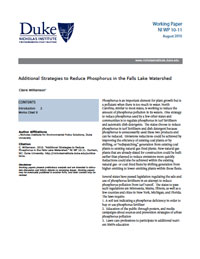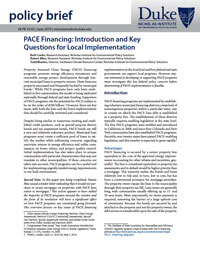Publications
Better Health through Improvements in Water and Sanitation
While significant progress has been made towards addressing the challenge of providing basic water access, there are still nearly one billion people who lack convenient access to safe water, most of them in sub-Saharan Africa and South and East Asia. Furthermore, over two and a half billion people in the world lack access to adequate sanitation. This brief examines an integrated approach of water, sanitation, and hygiene which will maximize health impacts.
(If) Things Fall Apart: Searching for Optimal Regulatory Solutions to Combating Climate Change Under Title I of the Existing CAA if Congressional Action Fails
If legislative prospects for a national climate change bill fail, the U.S. Environmental Protection Agency retains a number of options under the existing Clean Air Act to create a cap-and-trade program that could, in many ways, mimic a congressionally created regime. Under Title I in particular, EPA could turn to the NAAQS program or the new source performance standards and existing source regulation. Various legal constraints, however, may be imposed up these different statutory hooks. Examining the interplay between these regulations suggests that the EPA may need to move in an incremental fashion, given the uncertain statutory authority and legislative process.
Forum Summary: Allocation in Fishery Management
Summary of the Fall 2010 Fisheries Forum on Allocation in Fishery Management held in Monterey, California.
The Near-Term Market and Greenhouse Gas Implications of Forest Biomass Utilization in the Southeastern United States
Additional Strategies to Reduce Phosphorus in the Falls Lake Watershed
Phosphorus is an important element for plant growth but is a pollutant when there is too much in water. North Carolina is working to reduce the amount of phosphorus pollution in its waters. One strategy used by a few other states and communities is to regulate phosphorus in turf fertilizers and automatic dish detergents.
The Potential Role for Management of Public Lands in Greenhouse Gas Mitigation and Climate Policy
Public lands, including federal and state lands, offer significant opportunities for increasing greenhouse gas (GHG) mitigation from the management and restoration of forests, rangelands, and wetlands. This paper provides a rough estimate of the potential mitigation opportunities from public lands, including near-term sequestration generated from an elimination of timber harvests in public forests and improving management of some rangelands. It also presents policy options that decision makers and land managers can pursue to increase mitigation on public lands. This is a revised version of a paper that was published in July 2010.
Renewable Energy in the South: A Policy Brief
This working paper assesses the economic potential of renewable electricity generation in the South under alternative policy scenarios. Using a customized version of the National Energy Modeling System (NEMS), we examine the impact of 1) expanded and updated estimates of renewable resources, 2) a Renewable Portfolio Standard (RPS), and 3) a Carbon-Constrained Future (CCF). Under the Expanded Renewables Scenario, renewable electricity generation doubles the output of the Reference forecast for the South. If a Federal RPS is imposed or the policies represented by our CCF scenario are implemented, we estimate that 15% to 30% of the South’s electricity could be generated from renewable sources. Among the renewable resources, wind, biomass, and hydro are anticipated to provide the most generation potential. As the integration of renewable sources expands through the modeled time horizon, wind gradually out-competes biomass in the renewable electricity market. Cost-effective customer-owned renewables could also contribute significantly to electricity generation by 2030 in the South, under supportive policies.
State of the Southeast: How Cities are Addressing Climate Change
The Southeast faces unique challenges in attempts to mitigate greenhouse gas emissions and prepare for the impacts of climate change. It is one of the fastest-growing regions of the United States. The region also enjoys cheap energy relative to other regions in the U.S., which likely factors into its disproportionate energy use. In addition, a number of recent reports have detailed the ways climate will change in the Southeast, revealing significant vulnerabilities and risks. But the region’s leadership at the state and federal level has often voiced opposition to climate action. These contradictions make local efforts to mitigate emissions and prepare for climate change both difficult and imperative.
Assessing Climate Change Risks, Vulnerabilities, and Responses in the Siphandone/Stung Treng Area with a Focus on Protecting Vulnerable Ecosystems
This workshop report reflects discussions and analysis conducted by 16 regional experts who gathered to test the methodology outlined in Flowing Forward with reference to the Siphandone/Stung Treng area in the Mekong River basin. The findings presented here highlight the significant effects of both climate change and development pressures on ecosystems and livelihoods in the case study area and discuss the ongoing and potential future policy and infrastructure responses to changing circumstances.
PACE Financing: Introduction and Key Questions for Local Implementation
Property Assessed Clean Energy (PACE) financing programs promote energy efficiency investment and renewable energy project development through lowcost municipal loans to property owners.










